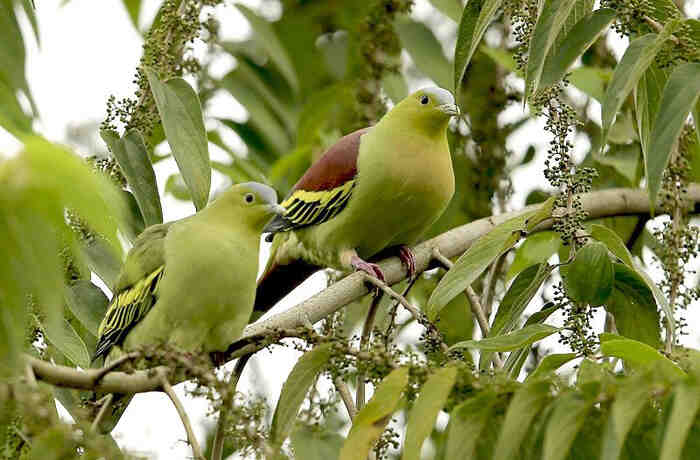Treron pompadora
IUCN
LCBasic Information
Scientific classification
- name:Treron pompadora
- Scientific Name:Gray-headed green pigeon, Gray-headed mountain pigeon,Treron pompadora,Pompadour Green-pigeon
- Outline:Landfowl
- Family:Columbiformes Columbidae G.Pigeon
Vital signs
- length:25.8-28.6cm
- Weight:141g
- lifetime:About 15-20 years
Feature
The back of the neck to the upper back is dark green, and the lower back and shoulders are dark purple chestnut, forming a wide "V"
Distribution and Habitat
Distributed in Bangladesh, Bhutan, Cambodia, China, India, Indonesia, Lao People's Democratic Republic, Myanmar, Nepal, Philippines, Sri Lanka, Thailand, Vietnam.
Grey-headed Green Pigeon is a resident bird, living in tropical rainforests and secondary forests below 1,500 meters above sea level, and sometimes in shrubs, but it does not land on the ground, and generally lives and moves on trees.
Appearance
The forehead to the nape of the male grey-headed green pigeon is blue-gray or pale-gray, with the forehead lighter in color. The back of the neck to the upper back is dark green, and the lower back and shoulders are dark purple-chestnut, forming a wide "V" shape, which is one of the main differences between it and other green pigeons. The waist is dark green, gradually turning yellow-green downwards. The tail feathers are olive green, and the outer tail feathers have gray-white terminal spots and black secondary terminal spots. The small coverts on the wings are also dark purple-chestnut, blending with the purple-chestnut on the shoulders and back to form a large patch. The coverts and large coverts on the wings are black with broad bright yellow feather edges, and the flight feathers are black. The sides of the head, chin, throat and front neck are bright yellow-green, and the upper chest is orange-yellow, forming an orange-yellow chest band across the upper chest, which is
Details
Grey-headed green pigeons are called Pompadour Green-pigeon in foreign language, and there are 8 subspecies.

Grey-headed green pigeons like to live in lowland evergreen rainforests in small or large groups. They often visit saline land. They often move in groups, starting to move and forage after daybreak, resting in the shade of trees at noon, and continuing to move and forage in the afternoon when the weather is cool. In the morning and evening, they also go to streams or rivers in groups to drink water. They are very noisy when they are active, and their calls are relatively soft whistles. They mainly feed on the fruits of banyan trees, and also eat fruits and seeds of other plants. They have a large appetite.
The breeding season of the Grey-headed Green Pigeon is from April to August, and they lay 2 nests a year. They usually nest on the branches of trees or shrubs in the forest, and also on small trees or bamboo branches in the bamboo forest or the jungle beside the land. The height of the nest is generally less than 4 meters from the ground. The nest is very simple, mainly made of small dead branches. Both male and female birds participate in nesting activities, usually the male is responsible for collecting nesting materials, and the female is responsible for building the nest. Each nest lays 2 eggs, and the color of the eggs is white.
During the brooding period, pigeons secrete pigeon milk under the action of prolactin (also known as prolactin) secreted by the posterior pituitary gland. Pigeon milk is composed of fat particles, emulsified fat chyle and lymph fluid secreted by the proliferating flat epithelium of the bilateral lateral sac lymphatic area of female and male pigeons, that is, the crop bed lymphatic area. After the colostrum period, chyle rich in emulsified fat particles is gradually added. The epithelial lymph papilla of the crop bed generally begins to sprout on the 4th to 5th day of the incubation state. The crop bed of male and female pigeons begins to sprout, the blood vessels of the crop bed are congested and thickened, and the lymphatic vessels proliferate. On the 8th to 9th day, the crop epithelium thickens and enters the pre-brooding state. On the 13th day, its thickness and width have doubled. On the 14th-16th day, it can secrete transparent slightly yellow pigeon milk. On the 18th day, the crop can secrete throat milk. However, on the 7th day after the squab hatches, the amount of crop milk secretion begins to decrease, and the secretion stops on the 10th day. It continues to vomit until the chicks are about 2 weeks old, and the crop bed begins to shrink, and the secretion of pigeon milk gradually stops. The semi-finished chyme that is ground by the gizzard and returned from the glandular stomach is gradually mixed into the chyme, and then it becomes a granular feed mixed with water for direct feeding. If the incubated eggs fail to hatch on time, pigeons with good hatching performance can continue to incubate until the 22nd-24th day at most (these are all related to the incubation performance of the pigeon, the hatching season, the feedback of embryonic development information, the frequency of hatching of the fetus, etc. In the cold winter and spring and the brooding period, the incubation period will often be automatically extended, and it is often difficult to persist in the hot and humid days of summer). At this time, the brooding pigeons will automatically stop incubating with the shrinkage of the crop bed.
Listed in China's "Yunnan Province Rare and Protected Animals List".
Listed in the 2012 Red List of Endangered Species of the World Conservation Union (IUCN) ver3.1-Least Concern (LC).
Listed in the second level of the "China National Key Protected Wildlife List".
Protect wild animals and eliminate game.
Maintaining ecological balance is everyone's responsibility!








